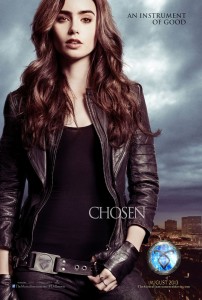The Mortal Instruments: City of Bones
Posted on August 20, 2013 at 6:00 pm
B-| Lowest Recommended Age: | Middle School |
| MPAA Rating: | Rated PG-13 for intense sequences of fantasy violence and action and some suggestive content |
| Profanity: | Some strong language |
| Alcohol/ Drugs: | Fantasy drugs |
| Violence/ Scariness: | Fantasy-style peril, action, and violence, characters injured and killed, monsters |
| Diversity Issues: | Diverse characters |
| Date Released to Theaters: | August 21, 2013 |
| Date Released to DVD: | December 2, 2013 |
| Amazon.com ASIN: | B009AMAKWM |
The first volume of Cassandra Clare’s popular YA The Mortal Instruments series has been respectfully brought to screen in another attempt to tap into the Harry Potter/Twilight/Hunger Games/Buffy audience. The problem is that fans of those series may find that too much of this story is derivative of themes, characters, and quests they have already seen.

Lily Collins (“Mirror Mirror”) plays Clary, the teenaged daughter of an artist single mother (Lena Headey). We first hear her on the phone, telling a friend that she isn’t going to lie to her mother. ” I’m just not going to tell her.” This sets the stage for a story that will have Clary discovering how much has not been told to her.
She wasn’t telling her mother that she planned to go clubbing. She finds a goth-ish sort of place and gets past the doorman with her friend Simon (Robert Sheehan), who clearly wishes he was more than a friend. Clary sees people and symbols that no one else does, including what looks like a murder. It turns out that she sees these things because she is not entirely human. Her mother never told Clary that she was born into a race of Shadowhunters, who protect the world from demons. Her mother is also a Shadowhunter, who disappears after the thugs who work for the evil Valentine (Jonathan Rhys Meyers) come after her to find a special cup that is one of the three “mortal instruments” that can grant special powers. The rest of this first chapter (the second is already in production) will consist of her learning what her heritage means as she tries to find her mother. And, in what has now become a tradition in multi-volume stories for teenagers, navigating a love triangle.
The movie benefits from Clare’s sense of humor and broad humanism, both evident here. There are not many stories in this genre that take pains to point out that people all religious beliefs are together in supporting the work of the Shadowhunters — or that acknowledge gay characters with such unquestioned support. Production designer François Séguin and composer Atli Örvarsson create a nicely gothic atmosphere in the midst of New York City, as Clary discovers her ability to see the other world beyond the one where the “mundanes” (humans) live. A leonine Shadowhunter named Jace (Jamie Campbell Bower) takes her to a sort of Victorian mansion of a clubhouse, presided over by an Anthony Stewart Head-type named Hodge (Jared Harris), where she will be safe from demons, werewolves, vampires, and various other things that go bump in the night, due to a non-aggression pact. And also zombies, because they don’t exist.
Clary learns that her memories have been hidden from her. The symbol that she felt compelled to draw and redraw until her bedroom was covered with the image (as she points out, like Richard Dreyfuss in “Close Encounters of the Third Kind”), is one key. A spooky group of hooded guys with their mouths sewn shut give her a magical equivalent of sodium pentothal to help her remember. But it is really in discovering her own power and in the intense connection she feels to Jace that begins to lead her to the answer.
As with most adaptations of beloved books, this film plays to the fans, including some scenes that could have been trimmed and assuming a knowledge of the characters that may leave audiences new to the story lacking the information they need to connect to the characters. There are some intriguing ideas and settings. But when it all comes together at the end in what seems like a mish-mash of “Star Wars,” “Batman,” and “Buffy,” much of the goodwill toward the story is dissipated.
Parents should know that this movie has a great deal of fantasy violence and action, though the worst of it is implied or off-screen. There are monsters of many different kinds and some gruesome and disturbing images. There are a few sensuous kisses and some sexual references, some crude, and characters who are powerfully attracted to one another discover they might be siblings. Characters use strong language.
Family discussion: Why did Jace, Isabelle, and Alec respond differently to Clary? How did Clary’s ideas about herself and her mother change as she was able to remember more?
If you like this, try: the books by Cassandra Clare and “Buffy the Vampire Slayer”
